
An American in Paris (1951) is one of the greatest, most elegant, and most celebrated of MGM's 50's musicals, with Gershwin lyrics and musical score (lyrics by Ira and music by composer George from some of their compositions of the 20s and 30s), lavish sets and costumes, tremendous Technicolor cinematography, and a romantic love story set to music and dance. Gene Kelly served as the film's principal star, singer, athletically-exuberant dancer and energetic choreographer - he even directed the sequence surrounding "Embraceable You." The entire film glorifies the joie de vivre of Paris, but it was shot on MGM's sound stages in California, except for a few opening, establishing shots of the scenic city. Nonetheless, it remains one of the most optimistic American films of the post-war period - with Paris at its center.

The film brought eight Academy Award nominations and won six of them - none of which were for acting: Best Picture (Arthur Freed, producer), Best Story and Screenplay (Alan Jay Lerner), Best Color Cinematography, Best Color Art Direction/Set Decoration, Best Musical Score, and Best Color Costume Design. Its nominations for director (Vincente Minnelli) and Film Editing were unrewarded. Gene Kelly received an Honorary Award from the Academy the same year, presumably for his contributions to this film - it was presented "in appreciation of his versatility as an actor, singer, director and dancer, and specifically for his brilliant achievements in the art of choreography on film." Nineteen year-old Leslie Caron made her film debut as the young Parisian mademoiselle.
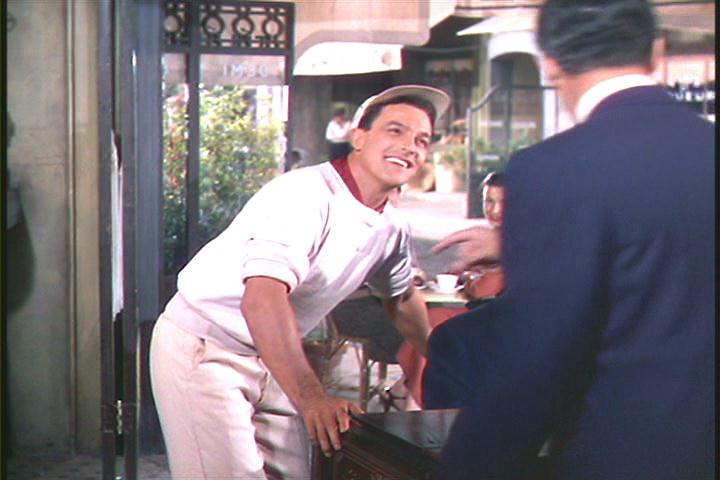

An American in Paris - and Gigi (1958), were among Minnelli's most successful films, and two rare nuggets of gold among MGM's Golden Age of Musicals. [The Arthur Freed unit at MGM Studios was well known for its production of other wonderful films: Singin' in the Rain (1952) that re-invented the musical in the 1950s, and Minnelli's own Meet Me in St. Louis (1944), The Pirate (1948) and The Bandwagon (1953), among others.] It was one of the few musicals ever voted Best Picture in Oscar history, and one of only a few Best Picture winners with no acting nominations.
It is an integrated musical, meaning that the songs and dances blend perfectly with the story. As in many musicals, the plot of this film is not its most important element. One of the film's highlights is its impressive finale - an ambitious, colorful, imaginative, 17-18 minute avante-garde "dream ballet" costing a half million dollars to produce. The pretentious sequence, featuring an Impressionistic period daydream in the style of various painters, is one of the longest uninterrupted dance sequences of any Hollywood film, and features the music of George Gershwin. [The success of the balletic themes in Michael Powell and Emeric Pressburger's British film The Red Shoes (1948) inspired Minnelli to follow suit - he had experimented with shorter ballet sequences in his earlier films Yolanda and the Thief (1945) and Ziegfeld Follies (1946).]
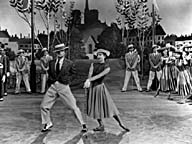
The film makes a transition from the real world into an elaborate fantasy to tell the story of his predicament and the ups and downs of their romance. Through free association in his mind, he brings together the city of Paris and its influential painters. The story of the 17-18 minute extravagant and imaginative dream ballet finale, "An American in Paris," also recapitulates Mulligan's plight in losing the girl he now loves - a parallel tale of an ex-GI who remains in Paris following the war and falls in love with a French girl - and loses her. Simultaneously, he views Paris through the colors and designs of some of its most famous painters.
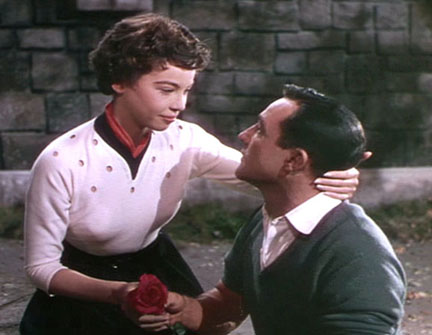
The varied artistic styles of the scenery, decor, and costumes for each of the six sequences are done in the styles of famous French painters - Manet, Renoir, Utrillo, Van Gogh, Rousseau, Dufy, and Toulouse-Lautrec. The dance and choreographic styles also range from modern dance and tap dance to jazz, classical, and ballet. Dazzling colors, music, rich backgrounds, camera movements, lightings, dance movements, costumes, decorations, sets, long takes, and special effects (colored steam, for example) provide an overwhelming impression, surreal at times.
Throughout the ballet, Jerry the painter continually sees, pursues, courts, and then loses Lise, moving through familiar Parisian locations, all in the style of the painters. The single connecting symbol that provides a transition between the six sequences is a red rose (representing the girl). Here is an "American in Paris" chasing after his French dream girl through the Paris of his favorite artists - their famous painting styles come to life. Her identity constantly shifts and changes as the mood, music and settings also vary in the Gershwin suite.
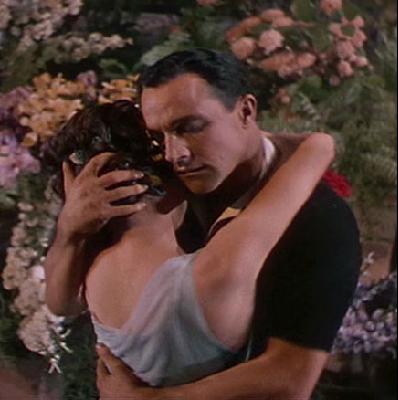
Sequence One: In a tracking shot, the two pieces of the torn charcoal sketch are swept along the gutter in a whirlwind of confetti until they suddenly unite and become the full-size Place de l'Etoile background of the same design for the opening sequence. In front of the black and white backdrop is a dramatic accent of color from a red rose dropped by Lise. A black-garbed Jerry materializes in the foreground, picks up the rose, and the backdrop suddenly explodes in color. The Place de la Concorde fountain (in Dufy style) swirls around as he dances through the sequence.
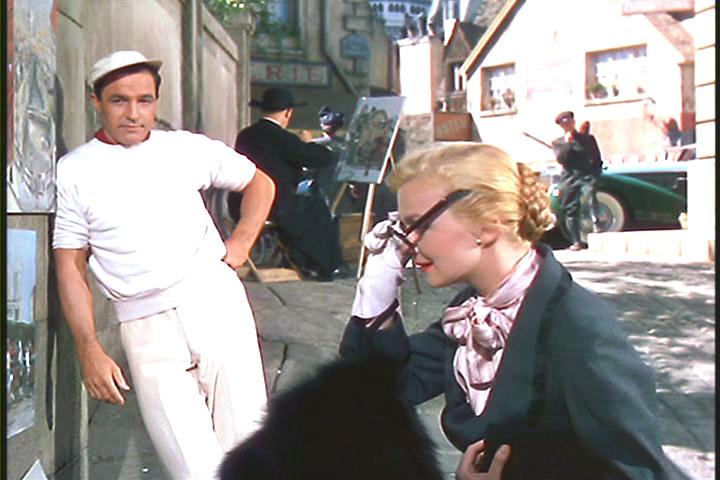
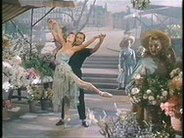
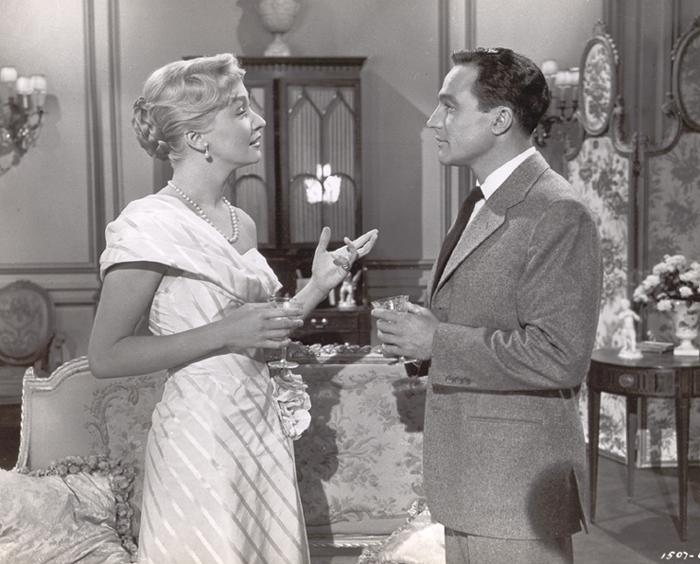
Sequence Two: a Madeleine flower market with a quiet lyrical mood (Manet or Renoir style); Jerry is joined in a street scene (inspired by Utrillo) by four GIs on French leave (the only part of the sequence in which Lise doesn't appear). This is followed by a march of spirited, strutting gendarmes set in a gaudy fairground. There are holiday throngs at the Jardins des Plantes, with Punch and Judy show, menagerie animals, blue-tighted acrobats, and schoolgirls (in a Rousseau setting).
Sequence Three: a continuation of the previous sequence, with the GIs (accompanying Jerry) as straw-hatted hoofers pursuing the dancing schoolgirls.
Sequence Four: a passionate emotional, mating dance (during a smoky night) between Jerry and Lise around a fountain in the Place de la Concorde (Dufy style). Then, the Place de l'Opera is seen in autumnal shades of color (Van Gogh style).

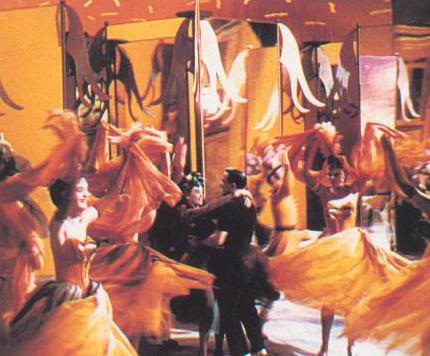
Sequence Five: a jazz-inspired sequence with Jerry as a muscular, white-tighted "Chocolat" (a famous Toulouse-Lautrec character) in a Montmartre cafe setting, with blonde cancan girls a la Moulin Rouge led by Lise.
Sequence Six (Finale): a return to the Place de la Concorde fountain. In the final sequence at the Dufyesque Place de la Concorde fountain, after a final burst of color and movement, everything suddenly vanishes - the crowd disappears.
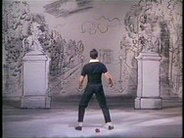 //
//
Jerry comes back to reality from his long dream/fantasy and finds himself alone with his red rose in front of the black and white sketch backdrop in a deserted Paris. The music builds to a crescendo with a zoom closeup of the red rose in his hand. The rose dissolves into his lovelorn, romantically desolate face.
On the Set
While Gene Kelly was an obvious choice for the role of Jerry Mulligan, casting the other roles proved to be a difficult task for director Vincente Minnelli and producer Arthur Freed.

Kelly was sent to Paris to test two up-and-coming French dancers: Odile Versois and Leslie Caron.
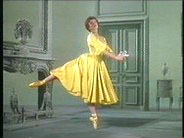 //
//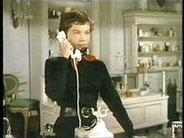 //
// //
//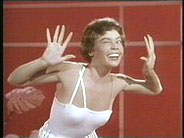 //
//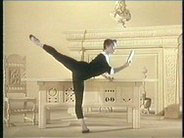
The not-yet eighteen-year-old Caron soon found herself coming to Hollywood to make her screen debut speaking English in the year's most anticipated musical spectacular. While Caron became an overnight sensation upon the film's release, the experience was not an easy one for her. She later complained that Minnelli did little to direct her, urging her, "Just be yourself." As a result, her inexperience and insecurities were reflected on film, lending Lise the degree of youthful confusion that the character required.
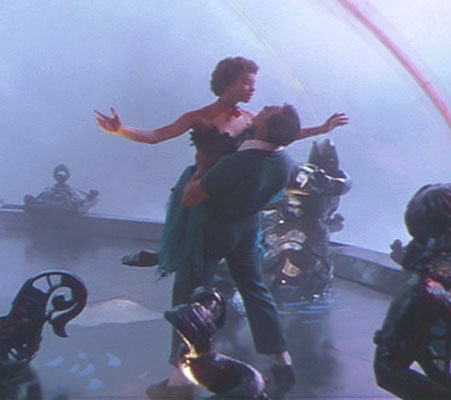
Filming was originally to include severals weeks of location work in Paris. But less than two weeks before shooting began, the decision was made to confine the film to the studio. The streets of Paris were recreated on the MGM lot, and the film's players found the set to be an easy and efficient place to work. Filming was largely hassle-free, and everything but the elaborate ballet was completed in six weeks. The ballet was a mammoth project, with an equally large allotted budget. Kelly choreographed the entire number, while Minnelli tackled the cinematic details. The greatest problems, however, were seen by the art department. The famous paintings in the backdrops had to be reproduced by the MGM artists at hundreds of times the original scale. Completing these final two reels of film was a battle unto itself.

Clips
Introduction to Movie
'S'Wonderful' sung by Jerry (Gene Kelly) and Henri (George Guetary)
Leslie Caron's Intro Into The Movie-Her Dance
I Got Rhythm-Gene Kelly Dances With the Kids
Jerry realizes what Milo wants from him
Our Love is Here to Stay-Jerry and Lise's Date
Gene Kelly Tap Dances During a Sequence of Finale
Leslie Caron Dances During A Sequence of Finale
Famous Lines
Jerry Mulligan ( Gene Kelly ):
"You must be out of your mink lined head."
Jerry Mulligan ( Gene Kelly ):
"Back home everyone said I didn't have any talent. They might be saying the same thing here but it sounds better in French."
Jerry Mulligan ( Gene Kelly ):
"That's quite a dress you almost have on. What hold's it up?"
Milo Roberts (Nina Foch):
"Modesty."
Information taken from An American In Paris on Filmsite.Org
Clips taken from Destination Hollywood's American in Paris Site
Some pictures taken from The Gene Kelly Ga
Favorite Movies に戻る
↑